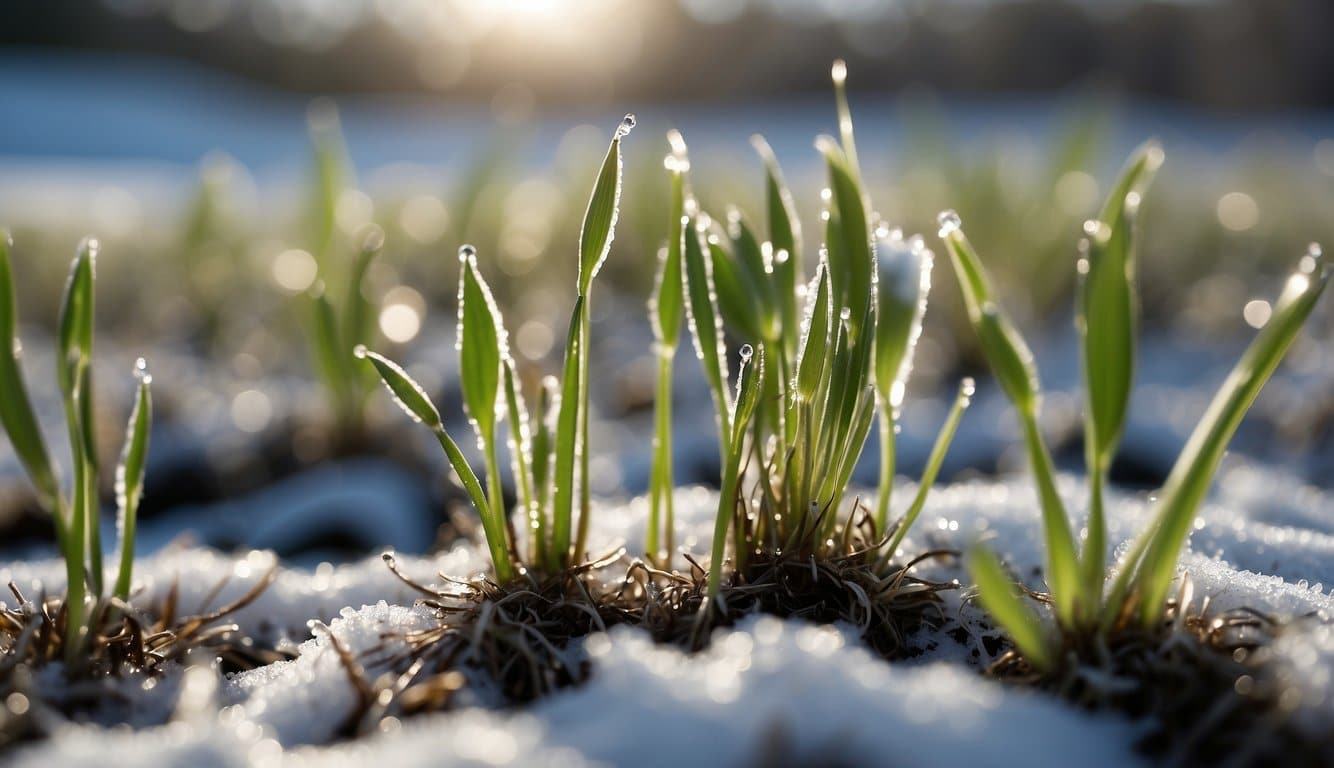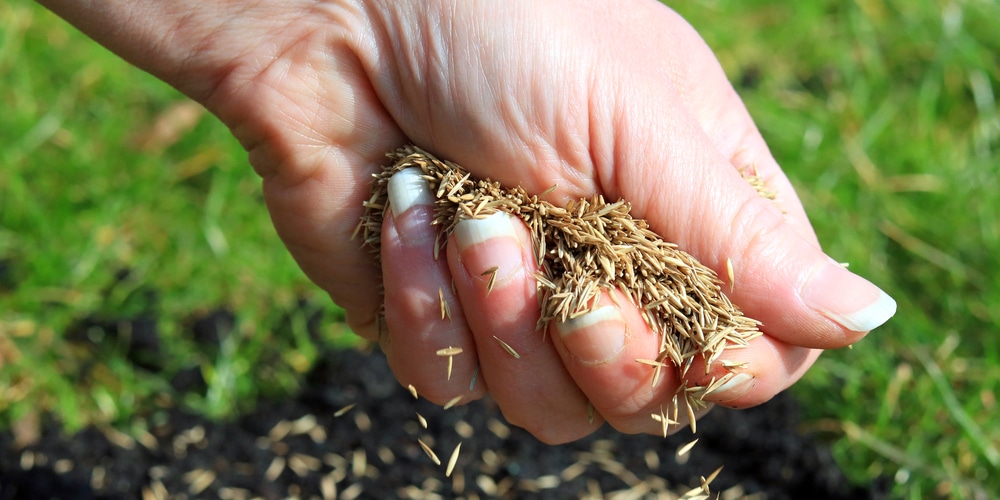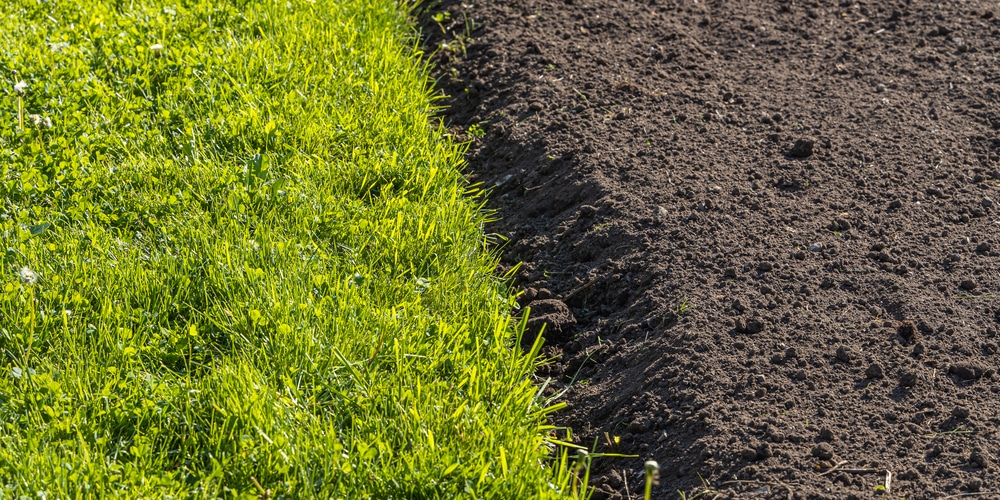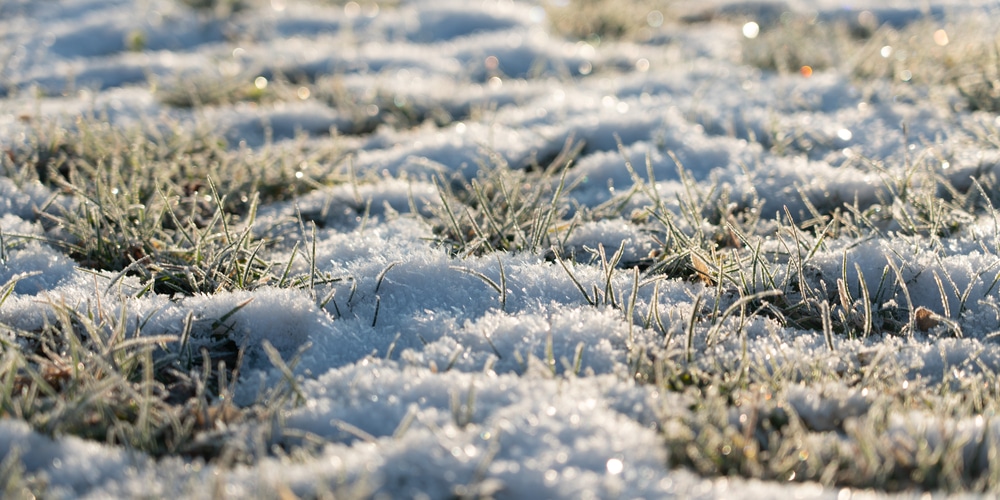| Question | Can You Plant Grass Seed in the Winter? |
|---|---|
| Answer | Generally no, but dormant seeding is an exception. |
| More Info |
|
Planting grass seed in the winter is not typically recommended due to cold temperatures and frost, which can inhibit seed germination and growth. However, a technique known as “dormant seeding” can be an exception.
This method involves sowing grass seed late in the fall or winter, allowing the seeds to lie dormant until early spring when conditions improve. Dormant seeding is done after the soil has cooled enough to prevent seed germination but before it freezes, usually late fall to early winter, depending on your region.
It’s most effective in areas with cold winters and a distinct spring thaw, as the natural freeze-thaw cycles can help improve soil-seed contact and prompt spring germination.
Grass Seed Germination Basics
The germination of grass seed is a process influenced heavily by temperature and seasonal conditions. Knowing when and how grass seeds sprout can help gardeners and homeowners establish a healthy lawn, even during the colder months.
Temperature Requirements for Seed Germination
Grass seeds have optimal temperature ranges for germination that vary depending on the species.
Cool-season grasses typically germinate between 50°F and 65°F, and warm-season grasses between 60°F and 75°F.
To ensure successful germination, soil temperatures should consistently remain within these ranges:
- Cool-Season Grasses: 50°F – 65°F
- Warm-Season Grasses: 60°F – 75°F
Germination rates can significantly drop if temperatures fall below or rise above these thresholds, as the seeds either enter dormancy or are exposed to stress that can prevent sprouting.
Winter Dormancy and Grass Growth
During winter, most grass seeds enter a state of dormancy due to temperatures consistently below optimal germination ranges.
The process, known as dormant seeding, involves:
- Seeding when soil temperatures are below 45°F
- Ensuring seeds remain undisturbed throughout winter
Dormant seeding capitalizes on the seasonal cycle, allowing seeds to naturally break dormancy and commence growth when conditions improve in spring.
While grass seeds can survive cold conditions, they will not germinate until the soil reaches adequate temperatures in the following growing season.
Choosing the Right Grass Seed
When planting grass seed in winter, the gardener must select the appropriate type. This means taking into account the seasonal growth patterns and the specific varieties that can endure the winter climate for successful germination and growth.
Cool-Season vs Warm-Season Grasses
Cool-season grasses thrive in the fall and spring’s cooler temperatures and can endure the frosty conditions of winter. Some common types include:
- Kentucky bluegrass
- Perennial ryegrass
- Fine fescue
- Tall fescue
They are ideal for northern regions where temperatures may fall below freezing.
In contrast, warm-season grasses such as Bermuda, Zoysia, and St. Augustine, are best suited to southern areas with mild winters.
These grasses often go dormant in winter and are not typically planted during the colder months.
Grass Seed Varieties Suitable for Winter Planting
For winter planting, dormant seeding is the go-to method. It allows the seeds to settle into the soil and be ready to sprout when the conditions are favorable in early spring. Some of the varieties suitable for this method include:
- Fine fescue: Tolerant of shade and poor soil
- Tall fescue: Adaptable and hardy
- Perennial ryegrass: Fast germination and growth
The gardener should consult local climate zones and consider the ground conditions to determine the most effective grass seed mix for winter planting.
Soil temperatures typically need to be consistently below 45 degrees Fahrenheit to prevent premature germination.
Preparing the Soil for Winter Seeding
Before sowing grass seed in winter, it’s crucial to prepare the soil properly to ensure the seeds have the best chance of establishing once the warmer weather arrives.
Soil Testing and Amendment
Soil testing should be the first step in the preparation process. A soil test determines the pH level and nutrient profile, enabling one to amend the soil as needed for optimal grass seed growth.
For example, if the soil is too acidic, one might need to add lime to increase the pH; if it’s too alkaline, sulfur may be required to decrease it.
After adjusting pH levels, homeowners should amend the soil with the necessary nutrients that were identified as deficient in the soil test. Common amendments include:
- Nitrogen
- Phosphorus
- Potassium
- Organic matter, like compost
Protecting Seed from Cold and Moisture
To protect the grass seed from the extreme cold and to avoid it from becoming waterlogged, it’s crucial to take steps for insulation and moisture management.
Covering the seed can be done with:
- A thin layer of straw to provide insulation
- Specialized seed coverings available in the market that also help retain moisture
Additionally, ensuring proper drainage is essential to avoid soggy conditions that can damage the seed.
Amend compacted soil by aerating it and adding sand or organic matter, as necessary, to improve drainage.
It is important to keep the seed moist but not waterlogged, and a balance must be struck where the soil is consistently damp but allows excess water to drain away.
Sowing Techniques for Winter Planting
When planting grass seed in winter, gardeners should focus on proper timing and protective measures to ensure seed viability until optimal germination conditions arise in spring.
Timing and Methodology
Planting grass seed during winter revolves around the concept of dormant seeding — sowing seeds when they’re unlikely to germinate until temperatures rise.
Ideal timing includes waiting for the soil to cool below 40 degrees Fahrenheit but not be frozen, often achieved in late winter.
The methodology for sowing grass seed is relatively straightforward. One should:
- Mow the existing lawn as short as possible without causing damage to the soil or roots.
- Spread seed during or after a light snowfall; a hand spreader effectively distributes seeds evenly and in the correct quantity.
- Employ the snow to nature’s advantage, as it will embed the seed into the soil during melting.
Mulching and Covering Seeds
After sowing, mulching plays a crucial role in protecting the grass seeds from wind, erosion, and foraging animals.
A thin layer of straw or compost can:
- Provide insulation from extreme cold.
- Maintain seed-to-soil contact.
- Reduce the chances of seed wash-away.
Covering seeds subtly after sowing — without burying them too deep — is important for maintaining adequate seed exposure to necessary elements for eventual germination.
A light rake across the seeded area can achieve this. Gardeners should:
- Avoid heavy foot traffic on the seeded areas to prevent soil compaction.
- Refrain from using herbicides until the grass has established.
Maintenance and Care After Seeding
Successful grass seed germination in winter relies on proper maintenance and care after seeding. Attention must be given to watering practices during the colder months and managing potential weeds and pests that can impede growth.
Watering Practices in Cold Weather
Even though evaporation rates are lower in winter, newly seeded lawns still require moisture.
Seedlings need to hydrate despite frosty conditions, but overwatering can lead to ice formation and can damage tender roots. Here is an advisable watering regimen:
- Monitor soil moisture: The top inch of soil should remain moist but not saturated.
- Water in mid-day: This allows time for water absorption before temperatures drop at night.
- Reduce frequency: Watering may only be necessary every few days, depending on weather conditions.
Managing Weeds and Pests
After dormant seeding, weeds and pests present a challenge to the developing grass.
- Weed deterrent: Apply pre-emergent herbicides compatible with the type of grass seeded to prevent weed growth without harming the new seedlings.
- Pest control: Regularly inspect for common pests such as grubs or fungal diseases. If problems arise, use appropriate pesticides or fungicides, ensuring they are safe for new grass.
Frequently Asked Questions
When preparing to seed your lawn during the colder months, it’s important to consider grass varieties and the timing of your planting to ensure optimal growth.
What is the best type of grass seed for winter overseeding?
For winter overseeding, cool-season grasses such as fescue, bluegrass, and ryegrass are recommended because they can germinate at lower temperatures and are hardy in cold climates.
Is there an optimal time for planting grass seed in cold climates?
The optimal time for planting grass seed in cold climates is late winter, just before spring thaw. This is when soil temperatures are consistently below 40 degrees Fahrenheit but not frozen, maximizing the seed’s time in the ground without germination.
How do temperature thresholds affect the germination of new grass seed?
Temperature thresholds are crucial for the germination of new grass seed. Cool-season grasses typically require soil temperatures to be at least 50 degrees Fahrenheit to germinate, whereas warm-season grasses need warmer soil temperatures closer to 65 degrees Fahrenheit.
What methods are recommended for dormant seeding of lawns?
Professionals often recommend dormant seeding. This involves sowing grass seeds during the winter months when the ground is not frozen so the seeds lie dormant until spring.
This can be done by scalping the lawn. Then, you can evenly spread grass seed. The seeds will settle into the soil as the snow melts.
Which grass seed varieties are most likely to thrive during the winter months?
Grass seed varieties that are most likely to thrive during the winter months include fescue. It is known for its tolerance to colder temperatures.
Another option is perennial ryegrass. This type of grass can establish itself quickly when temperatures rise in the spring.
Can grass seed be effectively applied directly to an existing lawn during the colder season?
Grass seed can be effectively applied directly to an existing lawn during the winter, primarily as part of a dormant seeding strategy.
The seeds will rest in the soil until the environmental conditions become favorable for germination, which often results in a fuller lawn come spring.
Last update on 2024-04-26 / Affiliate links / Images from Amazon Product Advertising API






